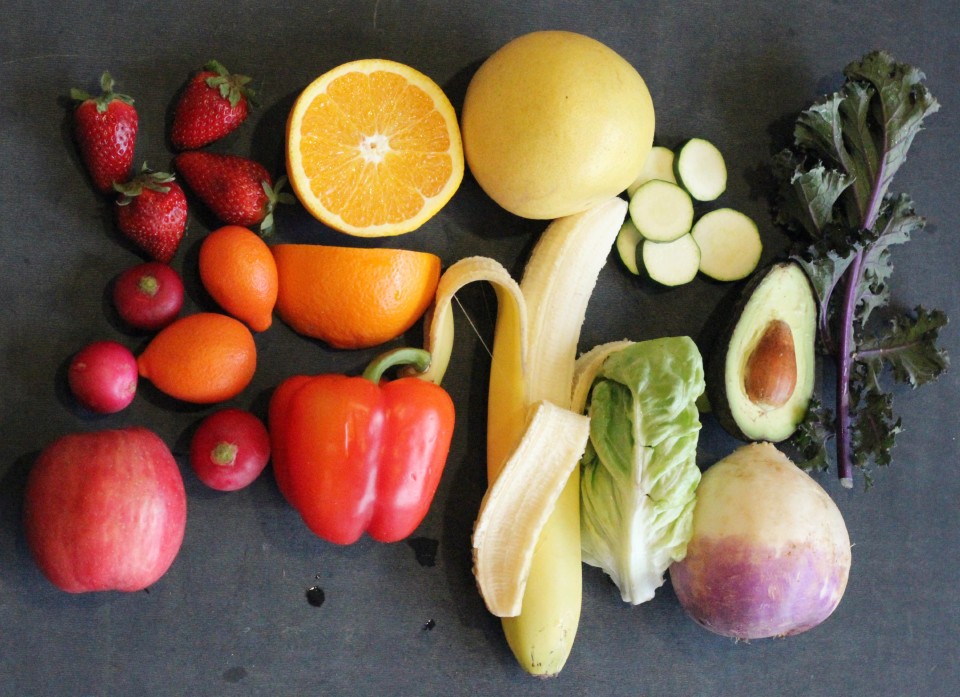 If you're a kid, it's recommended that you consume 20 cups of fruits and veggies a week, coming to just over 1,000 cups per year, according to the United States Department of Agriculture. But the difference between recommendations and actual practice is pretty stark—a study conducted by the National Fruits and Vegetable Alliance found that kids ages 2-12 were actually consuming only 200-300 cups a year. While the sheer quantity of fruits and vegetables is important to achieve, it’s also important not to overlook the variety of produce—and therefore, the variety of nutrients—your child is eating.
But don't panic. It's actually really easy to introduce kids to fruits and vegetables, especially if you know a couple tricks of the trade. At the Co-op, our weekly playgroup Co-op Kids utilizes an excellent method that's been proven to trump even the pickiest of eaters. It's called "Eat the Rainbow” and it encourages kids to use their senses, including their sense of adventure, to try different foods that are separated by color. This lesson has been quite successful, and to our surprise, the kids latched on to some of the more unique items like toasted seaweed, edamame and herbal tea.
If you're a kid, it's recommended that you consume 20 cups of fruits and veggies a week, coming to just over 1,000 cups per year, according to the United States Department of Agriculture. But the difference between recommendations and actual practice is pretty stark—a study conducted by the National Fruits and Vegetable Alliance found that kids ages 2-12 were actually consuming only 200-300 cups a year. While the sheer quantity of fruits and vegetables is important to achieve, it’s also important not to overlook the variety of produce—and therefore, the variety of nutrients—your child is eating.
But don't panic. It's actually really easy to introduce kids to fruits and vegetables, especially if you know a couple tricks of the trade. At the Co-op, our weekly playgroup Co-op Kids utilizes an excellent method that's been proven to trump even the pickiest of eaters. It's called "Eat the Rainbow” and it encourages kids to use their senses, including their sense of adventure, to try different foods that are separated by color. This lesson has been quite successful, and to our surprise, the kids latched on to some of the more unique items like toasted seaweed, edamame and herbal tea.
Here are some of our rainbow-inspired foods:
Red: red bell peppers, strawberries, tomato soup, cherry tomatoes, radishes and cranberry juice Orange: sweet potato chips, carrots, orange bell peppers, dried papaya, cheddar cheese and tangerine herbal tea Yellow: applesauce, corn, yellow summer squash, yellow bell peppers, yellow pear tomatoes, dried mango, pineapple and lemon slices in water Green: toasted seaweed, celery, green apple, kiwi, edamame, peppermint tea, baked snap pea crisps, cucumber slices and a leaf tasting with spinach, basil, butter lettuce and bok choy Purple: beet chips, purple cabbage, eggplant, plums, huckleberries and purple grapes White: cauliflower, jicama, parsnips, button mushrooms and fennel
Tips: Start small! When trying out new, exciting foods with kids, it’s natural for them to reject a few of the items you give them, regardless of how fun you make it. For this reason, we encourage parents to purchase smaller amounts of items when possible. Salad bars are a great place to start, as they often feature a wide variety of vegetables, fruits and grains to choose from. For instance, the Co-op salad bar features items like edamame, pickled red onion, beets with mint, spinach and sliced bell peppers. Make Rainbow Rice! Cook up some brown rice and let kids add vegetables to it, naming the colors along the way. Some favorites include corn, peas, cauliflower, purple cabbage, broccoli and red pepper. For fun, vibrant colors, steam the vegetables before adding to the rice. During colder months, this technique can be applied to Rainbow Soup, letting kids choose their own vegetables and beans to add to the stock. Dip it! Even the pickiest eaters like to dunk their food in sauces, dips, and spreads. Providing an array of dips and spreads makes trying new foods fun while empowering the child to make choices. Try serving cut vegetables with almond butter, hummus or a mixture of applesauce, cinnamon and wheat germ. Use your senses! The eating experience is so much more than just taste. Encourage kids to describe the texture and smell of each new food they try, and then when they taste it, ask them to make a comparison. Does star fruit taste a little like grapes? Do sweet potato chunks look like carrots? Making comparisons to fruits and vegetables the child already enjoys will encourage them to accept the new food.
This article, written by Sarah MacDonald, originally appeared in tag magazine on February 26, 2014.
